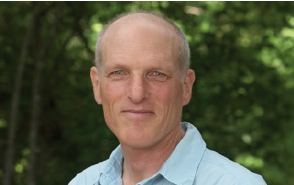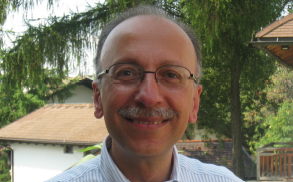Towards a Mindful Cognitive Science: An Insight Dialogue Retreat”, Chateau de La Bourlie (France)
September 22 – 29, 2014
A one-week Insight Dialogue retreat for specialists of neurocognition, cognitive psychologists, and philosophers of mind who have an established practice of meditation, and are ready to go further by undergoing a transformation of their own research and outlook by integrating mindfulness at the heart of it, developing the capacity to meditate while engaged in research, individually or with others.
Teachers
 Gregory Kramer, Ph.D. is the Founder and Guiding Teacher of Metta
Gregory Kramer, Ph.D. is the Founder and Guiding Teacher of Metta
Foundation and Metta Programs and has been teaching Insight Meditation since
1980. He developed the practice of Insight Dialogue and has been teaching it since 1995, offering retreats in North America, Asia, Europe, and Australia. He has studied with esteemed teachers, including Anagarika Dhammadina, Ven. Balangoda Ananda Maitreya Mahanayaka Thero, Achan Sobin Namto, and Ven. Punnaji Maha Thero. Gregory was a National Endowment for the Arts Composition Fellow and is the founding figure in the field of data sonification.
He edited “Auditory Display: Sonification, Audification, and Auditory Interfaces.” Gregory is the author of: Insight
Dialogue: The Interpersonal Path to Freedom (Shambhala), Seeding the Heart: Practicing Lovingkindness with Children, Meditating Together, Speaking from Silence: the Practice of Insight Dialogue, and Dharma Contemplation: Meditating Together with Wisdom Texts. Michel Bitbol, M.D., Ph.D. is Director of Research at Centre National de la Recherche Scientifique. Educated at several universities in Paris, he received a M.D. in 1980, a Ph.D. in physics in 1985, and an “Habilitation” in philosophy in 1997. Michel first worked as a research scientist in biophysics from 1978 to
Michel Bitbol, M.D., Ph.D. is Director of Research at Centre National de la Recherche Scientifique. Educated at several universities in Paris, he received a M.D. in 1980, a Ph.D. in physics in 1985, and an “Habilitation” in philosophy in 1997. Michel first worked as a research scientist in biophysics from 1978 to
1990. From 1990 onwards he turned to the philosophy of physics, where he developed a neo-Kantian approach. He edited texts by Erwin Schrödinger, and published books in French about quantum mechanics for which he received an award from the “Académie des Sciences Morales et Politiques.” A few years
ago, Michel focused on the relations between the philosophy of quantum mechanics and the philosophy of mind, working in close collaboration with Francisco Varela. He is now working in a research group of phenomenology on issues related to consciousness. He also has a long-term interest for the philosophy of the Madhyamika school.
Schedule
Monday, 22 September 2014, 5:00pm for dinner through
Monday, 29 September 2014, 9:30am after breakfast Location
Location
Le Château de la Bourlie is a beautiful château situated in the heart of the ancient and picturesque Périgord, France. Tucked away in the hills behind the main valley of the Dordogne, it occupies an idyllic site embedded in a large private estate.
Access by Train (Le Buisson station, on the Line Bordeaux- Sarlat), or by Plane (Bergerac airport, connected to London and Paris). Visit www.chateaudelabourlie.com for further details.
Cost
€ 563 includes meals & private accommodation in a double bedroom.
Contact & Registration
By invitation only
Stefano Poletti at mindfulcognitivescience@gmail.com
This retreat has been organized thanks to the financial support of Consciousness, Mindfulness, Compassion – CMC International Association, NOUS – Scuola di Psicoterapia, Milano, and Metta Programs.
cognitive psychologists, and philosophers of mind who have an established practice of meditation, and are ready to go further by undergoing a transformation of their own research and outlook by integrating mindfulness at the heart of it. The specific interpersonal meditation practice of Insight Dialogue is intended to strengthen the researchers’ capacity to sustain mindfulness, concentration, and insight while engaged with other researchers and with conceptualization. In short, this is a training to support a rigorous methodology of mindful cognitive science.
Cognitive neuroscience and cognitive psychology are disciplines that purport to develop our knowledge about the mind. Yet they are at the same time practices within the minds of the specialists of these sciences. They use methods that are appropriate for objective explanations, but their theme of investigation is inextricably linked with subjective experience; not only the reconstructed experience of the human subjects of experiment, but also the lived experience of the scientists who figure out and interpret the former. The recognition of this “strange loop” of the knower and the known in cognitive knowledge is usually underrated or postponed, so as to focus research on easily sorted out problems and promote fast-paced progress. But ignoring it completely is not a viable option in the long term, for three reasons at least.
Firstly, the objective findings of cognitive neuroscience draw their mentalistic meaning and their relevance for concrete human beings from nowhere else than their systematic correlation with reports of lived experience. After all, “With no (subjective) reports, there is nothing to which neural variability can be related,
and it will forever remain meaningless noise”1.
Secondly, objectivist theories of social intercourse (such as the “theory theory” and the “simulation theory”) are increasingly criticized, and they tend to be replaced by other theories (such as the “interaction theory”) that take into account the lived and enacted co-emergence of the embodied experiences of individuals
engaging in mutual relations2.
Thirdly, at the far end (and right at the beginning!) of an inquiry in the cognitive science, one faces the well-known “hard problem” of the alleged physical origin of consciousness. In view of its manifest intractability, one is bound to realize sooner or later that this problem is a sort of artifact of the objectifying stance itself, and that it therefore requires a “methodological remedy” rather than a “solution”3. But this
realization is by no means easy, when one is systematically trained to an attitude of intentional directedness (namely to a practice of aiming at, grasping and manipulating objects), and tends accordingly to overestimate the value of this attitude by granting the manipulated objects an ontological status.
These two distortions, i.e. early and intensive training to objectification and ontological solidification of the objects of knowledge, are typical of our scientific era. They are also promoted by the economical transformation of any living process into a “thing” subject to manipulation or into a “good” subject to trade4.
Full conversion of our approach of the “hard problem” of consciousness is therefore conditional on a radical change of attitude and even maybe of civilizational orientation. In the suitable alternative attitude, our ontological standards are recognized to be underpinned by a standard of self-evidence, and our standard of objectivity is seen to be grounded on a more general demand of intersubjective agreement. But such a momentous change in attitude can occur only if one fulfills the visionary dream of Francisco Varela (who was clearly a brilliant forerunner of mindful cognitive science): “My proposal implies that every good student of cognitive science who is also interested in issues at the level of mental experience, must inescapably attain a level of mastery in phenomenological examination in order to work seriously with first-person accounts. But this can only happen when the entire community adjusts itself – with a corresponding change of attitude in relation to acceptable forms of argument”5.
At this point, it must be understood that the adjustment of the “entire community” as advocated by Francisco Varela, cannot be obtained cheaply. It cannot content itself with inviting “specialists” of mindfulness (say highly trained Buddhist monks) in a laboratory of neurocognitive science, to work with scientists and/or to become their objects of study. For this is only one half of Francisco’s vision. It cannot be reduced either to asking the neuroscientists to train themselves to mindfulness in order to understand from within what it is like to experience meditative states of consciousness. It should have the ambition of helping many specialists of cognitive science to reach and maintain throughout their research the enhanced state of being that was utterly familiar to Francisco Varela: a complete merging of mindfulness and intellectual or experimental activity; a mindful dynamics of neurocognitive research that entirely transfigures the aims, problems, meanings and conclusions of this inquiry. It should purport to found a community of mindful cognitive scientists, who suffuse their science with mindfulness, instead of just having two separate threads of life, one on the cushion and the other in the lab. Clearly, a research community founded with this vision must also have a mindfulness practice that encompasses the communicative flow at the heart of collaborative research: within research teams and within the larger research community. In such a practice, direct apprehension, conceptualization, and communication are conjoined.
A tentative move in this direction is proposed by way of a week-long seminar and retreat. This retreat concerns around 20 specialists of neurocognition, cognitive psychologists, and philosophers of mind who
have an established practice of meditation, and are ready to go further by undergoing a transformation of their
own research and outlook by integrating mindfulness at the heart of it. The idea is to train these researchers in what we might call a self-aware intersubjective approach of the topics they usually deal with by a narrowly objectivist and individualistic approach. This will be obtained by a relational meditation practice taught in conjunction with traditional, individual and silent Buddhist meditation. From the standpoint of meditation, we are talking about establishing the acute sensitivity associated with traditional (silent) meditation, but doing so in such a way that language, indeed all the constructing processes of mind, i.e. all conception, imaging, and so on, are not distant from but adjacent with clear, non-clinging, concentrated awareness. Such a flexibility of meditative capacity, or skill, is therefore accessible while speaking (if one includes the pauses that naturally arise during such practice), while intentionally developing concepts, and while engaging generally with (a controlled subset of) the active world. That is, one will develop the capacity to meditate while engaged in research, individually or with others.
Of course, there are limits to what activities can be encompassed while sustaining the stability of the meditation. In Gregory’s experience, the speed or turbulence of activity – of conceptualizing, speaking, or acting bodily – at which one can maintain meditative constancy is slow by the standards of normal conversations or instrumental actions. However, the refinement of attention and incisiveness of intellect available during Insight Dialogue can be surprising to the seasoned traditional meditator. That is, approached with patience and skill in method, norms of interpersonal reactivity can be shifted to interpersonally intensified mindfulness and concentration. This could serve to amplify the criteria of intersubjective understanding about scientific topics by refining the stability and sharpness of subjective experience.
Insight Dialogue, developed as a liberative Buddhist practice, has evolved to meet a significant problem: when it is engaged in intellectual tasks, the thinking, emoting, and generally agitated mind becomes even more agitated; therefore the mind becomes less stable in present-moment mindfulness and concentration. As a result, truly mindful thinking is not possible. Furthermore, meditative stability all but vanishes for most people when they engage with other people. The human mind, finely tuned by evolution to be highly sensitive to other humans, diminishes in clarity and stability when interpersonally engaged. Traditional meditation practice, which takes place entirely intrapersonally, provides the necessary foundation for stable meditation, i.e. the experience of basic mindfulness and some degree of tranquility. Silent practice does not, however, equip the mediator to make the jump to the interpersonal. But with a foundation in individual meditation, one can gradually and methodically develop a high level of interpersonal mindfulness together with a surprising degree of concentration. Deep inquiry and tranquility can co-exist in a balanced way. To accomplish this, method is important.
The key to meditative development in Insight Dialogue is a set of six meditation instructions, or guidelines, each designed to foster different facets of the mind. This is described in Gregory’s book “Insight Dialogue: the Interpersonal Path the Freedom”, or, as a stop gap, see www.metta.org for a description of these guidelines. In brief, they are Pause, Relax, Open, Trust Emergence, Listen Deeply, and Speak the Truth. The simplicity of these verbal handles is intentional; as practice deepens one needs to access these reminders with
a light touch so as to refine one’s meditative qualities while continuing to meditate with another. Let us unpack these guidelines just briefly.
Pause: This is, of course, just stopping long enough to pay attention to experience in the here and now. In other words, the Pause is mindfulness. It refers also to the mind of non-clinging and it exercises the move of letting go of the mind’s current fixation.
Relax: This refers to bodily relaxation at the surface level, which can be a helpful entryway into the deeper layers of practice. What relax is to the body, accept is to the mind, so Relax also refers to an attitude or receptivity, non-resistance. This ripens into tranquility and concentration.
Open: This is the key instruction that opens the practice into relationality. It refers to mindfulness established internally, externally, and both internally and externally. It also opens into a spatially extended quality of mind. When Pause-Relax-Open come together, you may experience mindfulness and concentration established that opens experience beyond the usual limits of the individuals “island universe” (to quote Huxley).
Trust Emergence: This is an instruction to attend to, attune to, impermanence. Its development leads to a flexible and therefore robust quality of concentrated awareness. It also refers to what Zen calls “don’t know mind”. One dwells in the changing moment, not grasping at any idea, emotion, or sensory event, but dwelling in the emergent quality of moment-by-moment experience. One releases in each moment into the rising and vanishing of experience.
Listen Deeply: Clearly this has a surface quality of paying attention to another or others. Developed as mediation practice, it involves a profound, continuous receptivity to arising experience with the particular other. Language is not left out of the meditative field.
Speak the Truth: This instruction refers to nothing less than maintaining mindfulness at the boundary of awareness and language. This includes ones internal language: the thinking, conceiving, verbal, narrative, or otherwise activated mind; as well as the language or the otherwise active presence of the other – human or otherwise. So this instruction is crucial for cultivating meditative awareness amidst the one’s casserole of constructing process. As one becomes skillful in this meditation instruction, one can nimbly move back and forth between identified and unidentified experiencing, between, if you will, the constructed and unconstructed, or between awareness and conception or reaction.
Because Insight Dialogue attempts to foster genuine meditation practice in the face of the challenges of communication, conception, emotion, and so forth, Gregory has been teaching it primarily in explicit retreat settings. These retreats, modeled after his own learning environments offered to him generously by his Thai teacher Achan Sobin, are usually at least a week long and take place in noble silence; that is, meditators are silent except while practicing Insight Dialogue. This is necessary, or at least most efficient, when learning the practice. The habits of speech and thought are so strong that they must initially be dropped so as to not
lure the meditator back into the comfortable escapes of the habit-mind. During the first few days of retreat, the guidelines are introduced gradually, and at the same time the practitioners are becoming familiar with the retreat form and the likely unusual experience of co-meditation. On retreat, meditators are also supported by other retreat conditions, such as not reading, silent meditation spaced throughout the day, meals prepared for them, talks on mind and on practice, and so on. The practice grows stronger.
As the practice becomes stable, meditators are given increasingly weightier contemplations. That is, in addition to talking about moment-by-moment experience in the here-and-now, people are invited to speak about specific topics that guide the mind in beneficial ways. Inspired by one of Gregory’s Sri Lankan teachers, Ven. Punnaji Mahathera, at an Insight Dialogue retreat these contemplations are drawn from early (Pali tradition) Buddhist teachings and intended to shed light on suffering and the end of suffering. However, we plan to enfold within the practice “contemplations” on the mind and neurology per se. Even so, the contemplations must always open a doorway to immediate experience; abstraction can lead to a counterproductive distancing from experience.
While offering this retreat we will discern how a neuroscience-oriented Insight Dialogue retreat might unfold. Gregory has not previously done a retreat devoted to similar subject matter. But for the first retreat, anyway, we want to treat any heavy conceptual material with care, introducing it gradually and always in
ways that can be directly checked in actual experience. After all, it is the refined subjectivity that is the strong suit – together with the relationally enriched intersubjectivity – that makes Insight Dialogue such promising avenue for the kind of training that is needed to give birth to a “mindful cognitive neuroscience”, in alignment with Francisco Varela’s dream and personal practice. Such a retreat also stands to illuminate the intersection
of interpersonal and contemplative neuroscience, suggesting what Gregory refers to as interpersonal contemplative neuroscience. In any event, the genuine openness of the participants to this type of practice is essential. So the preliminary work we will do is explaining what we are doing and why, in terms that the potential retreatants can genuinely understand, will be critical to the success of this work.
To sum up, the seminar/retreat of mindful cognitive science will unfold as follows: 1) A time of presentation of the vision and method, 2) A time of practice of the meditative foundations of Insight Dialogue;
3) A time of interpersonal meditation, interleaved with silent meditation, with contemplations drawn from neuro-cognitive issues and their bearing for our minds, as gradually introduced as possible [(2) and (3) will engage the majority of our time on this meditation retreat]; 4) A time of philosophical reflection about what has been found and experienced; yet in the same atmosphere of “speaking the truth”.
Now, which outcomes do we expect from this seminar/retreat, apart from the new stance gained by the participants?
The first outcome we consider is to provide an instrument of greater coherence and communication among the attending scientists, including about hotly debated issues of the philosophy of mind, by promoting their fluency in the awareness that precedes conception.
Another, more immediate outcome, will be a synthetic document about the ways scientific problems and philosophical positions are modified at their root by the change of attitude that is likely to be promoted by the practice. This document will be written in the form of personal contributions of participants about the connection between their work, their conception of mind and consciousness, and the new perspective opened by integrating mindfulness in them. The document could well have the form of “proceedings”, published in a special issue of a journal. It hopefully could be turned into a detailed research program that would bind together the many investigations about various stages and various types of meditation, the commitment in practice of those scientists who are involved in such investigations, and the general philosophical outlook that more or less tacitly guides the researchers. A potential benefit, among many others, would be to provide a strong lived basis to many attempts at bypassing the purely interventionist conception of mental therapy that is
favored by the diffusion of psychotropic molecules, and promoting the “empowerment”6 of patients on their
own cure instead. Finally, it is hoped that relational mediation practice will lead to insights into the mind that yield both individual understanding and a shared vision of mindful neuroscience research.








